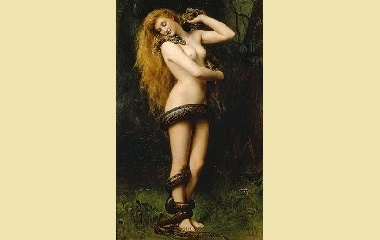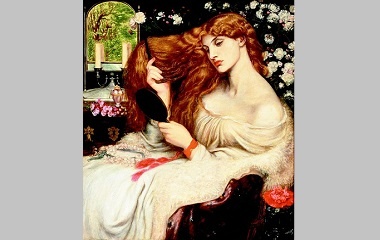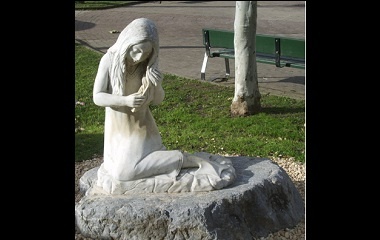Who is Lilith?
Lilith is a powerful creature who blurs the line between woman and demon. She upends traditional gender roles by seducing men and preying on infants, rather than nurturing them. Dark and ambiguous though she is, Lilith has gripped our imagination for centuries.
Characteristics
Physical Description
Lilith is more an idea than a physical being. Her name means “night creature,” and whatever shape she takes captures both the sensuality and terror of nighttime.
Mesopotamians connected Lilith with trees. Some sources describe her as a creature living in a tree, most likely an owl. The Burney Relief, a famous carving that is believed to be Lilith, shows a sensual woman with a curvy body, large, owlish eyes, wings, and taloned feet. Other texts claim that she is the branches of the tree itself.
Greeks and Romans feared a demon named Lamia, who is often considered to be a version of Lilith. Lamia was a dazzling creature, part woman and part serpent. The Lamia-Lilith-serpent connection spread to other cultures as well, inspiring countless paintings of Lilith with a serpent twining around her body.
Jewish and Christian traditions describe Lilith both as a seductive woman and a terrifying demon, but few details are added to her appearance.
Personality
At her most innocent, Lilith is a rebellious character who wreaks mayhem in the lives of men. She demands to be considered equal to men, and if she is denied, she uses her seductive charms to prove that she is actually their superior. At her darkest, Lilith is a hungry demon who targets pregnant women and newborn children.
Cultural Representation
Mesopotamia
In ancient Mesopotamia, Lilith was a nocturnal, winged demon who preyed on pregnant women and children. She was particularly fond of haunting villages in the desert. Many plaques and amulets have been unearthed, with inscriptions designed to ward off the demon, like:
“O you who fly in darkened rooms, be off with you this instant, this instant, Lilith. Thief, breaker of bones.”
Lilith appears in Mesopotamia’s most important text: The Epic of Gilgamesh. Inanna, a goddess of war and sensuality, is growing a willow tree, which she intends to use as the wood for her throne. One day, Inanna goes to water the tree and finds a dragon at its base, a zu bird in its branches, and Lilith making a home in its trunk. Gilgamesh kills the dragon for Inanna, and the bird and Lilith flee in terror.
Greece and Rome
While the Greeks and Romans did not discuss Lilith, they did have a similar demon, named Lamia, whose legend accidentally became intertwined with Lilith’s.
Lamia was a ravishingly beautiful queen and one of Zeus’ favorite lovers. When Hera found out about her, she transformed Lamia into a monster, half woman and half serpent, and forced her to eat her own children as punishment for her steamy affair with Zeus. Lamia had no choice to obey, but she lost her mind in the process. She spent the rest of her life stalking other children and devouring them, as she had done to her own.
Christianity and Judaism
Christian and Jewish scriptures only make passing references to Lilith.
The Bible mentions her in Isaiah 34:14, an apocalyptic passage that describes a kingdom of pagans turning into a chaotic desert:
“wildcats shall meet hyenas / goat-demons shall greet each other / there too the Lilith shall repose / and find herself a resting place.”
She is also listed among the demons in the Dead Sea Scrolls.
The Jewish Talmud, a collection of legal interpretations of scripture, describes Lilith as a succubus and advises men not to sleep in a house alone, less Lilith finds her way into their dreams. Special incantation bowls, with inscriptions used to ward off Lilith, have also been found in Jewish communities around Babylon.
Lilith’s real legacy in the Christian and Jewish faith wouldn’t emerge until the Medieval Ages, when The Alphabet of Ben Sira was published. This text gave a new interpretation of the chapter of Genesis, claiming that Adam had another wife before Eve. That wife was Lilith. She was made from the same clay as Adam, so she refused to be treated as his inferior. Instead, she abandoned him and wandered into the Red Sea, where she began to give birth to hundreds of demon children. God sent angels to return Lilith to Adam, but she refused, instead striking up a compromise with them. In exchange for her freedom, she would allow one hundred of her demon offspring to be killed per day, and she would leave any human children alone who wore amulets with the angels’ names.
Modern Appearances
The rise of feminine breathed new life into Lilith’s legend. Rather than demonizing her, women began to look to this fiery, independent woman as a source of inspiration. Occultists tried to invoke her power, while scholars used her as a way to study gender roles throughout history.
Lilith has also maintained her potent blend of sensuality and terror, which has made her a popular character in fantasy books and films.
Lilith






No comments:
Post a Comment